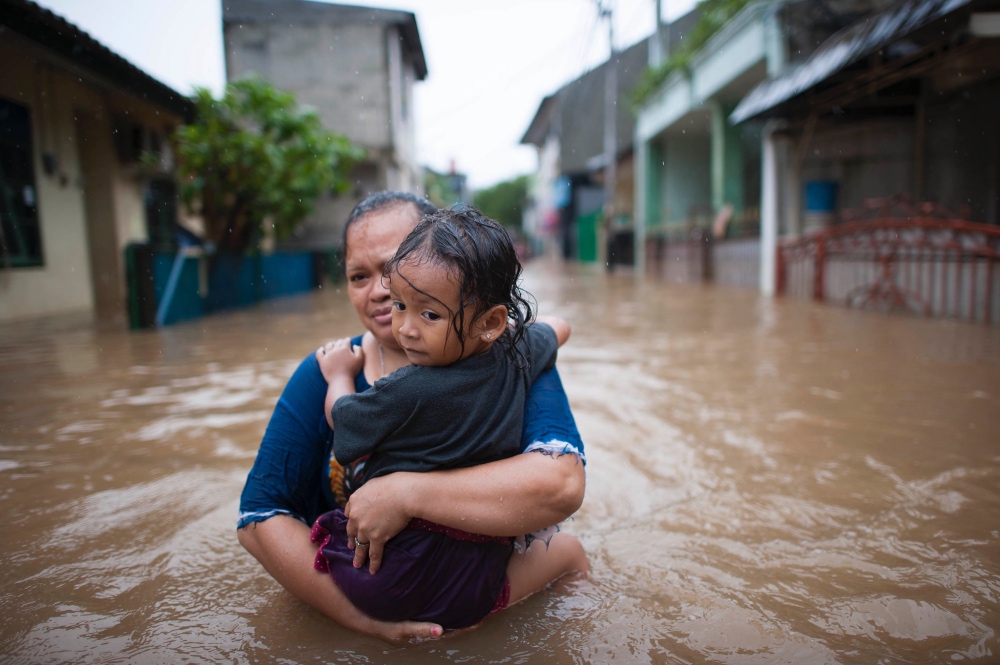Kuala Lumpur, Malaysia
Thomson Reuters Foundation
Indonesia’s flood-hit capital Jakarta must protect and plant trees, stop extracting so much groundwater, and develop long-term plans together with surrounding towns if it is to keep pace with the growing threats from climate change, green groups said.
Since 31st December, some of the heaviest rain since records began has caused chaos in the mega-city, killing at least 60 people and displacing nearly 175,000 – and more rain is forecast for this month.

Floods in Jakarta in 2017. PICTURE: World Meteorological Organization (licensed under CC BY-NC-ND 2.0)
“Indonesia has got enough resources to deal with these problems,” said Leonard Simanjuntak, country director for Greenpeace Indonesia in Jakarta.
“However, for decades, political leaders never really had any consistency in implementing long-term plans for flood management,” he told the Thomson Reuters Foundation.
South-East Asia’s biggest city is located by the coast and built on a swampy plain, with 40 per cent lying below sea level.
More than 10 rivers flow through the capital, but the water catchment areas and forests around it have been largely converted over decades for residential and agricultural use, falling victim to rapid urbanisation.
The capacity of Jakarta’s rivers has also shrunk because of sedimentation, poor waste management and illegal settlements, meaning remaining waterways tend to clog up during heavy rains.
Making matters worse, most residents and businesses rely on wells that drain underground aquifers for their water supplies, causing the city to sink by 5-10 centimetres each year.
Rising sea levels and the inability of infrastructure to cope with excess water during the monsoon season have resulted in regular flooding in the city, which is home to more than 10 million people.
Jakarta’s authorities must dredge and clean up its rivers and waterways, and help communities access water without huge, uncontrolled groundwater extraction, said Milag San Jose-Ballesteros, director of East, Southeast Asia and Oceania for the C40 Cities network.
Many cities, meanwhile, are now looking at nature-based solutions, such as turning concrete drainage and grey infrastructure back into flood-plains, she added.
Hidayah Hamzah, a forests expert at thinktank World Resources Institute Indonesia, said Jakarta could not solve its flooding problem alone.
“The city needs to collaborate with surrounding areas,” he said, adding the government should stop further urban conversion of forested areas and watersheds.
San Jose-Ballesteros noted that collaboration and alignment of long-term plans across cities and regions “would be crucial in addressing the issue”.
Swathes of Jakarta and nearby towns were inundated after heavy rain fell at the turn of the year.
The rainfall at the start of 2020 was one of the most extreme events since records began in 1866, said Indonesia’s state weather agency.
But Jakarta is no stranger to encroaching water. More than 50 people died in one of its deadliest floods in 2007 and five years ago much of the centre was inundated when canals overflowed.
Past floods highlight the importance of better early warning systems and community preparedness, said Abhas Jha, East Asia and Pacific manager for urban development and disaster risk at the World Bank.
The government has decided to move the administrative functions of the capital to Borneo island from 2024, to help reduce population pressure on Jakarta.
But it has pledged to spend $US40 billion to save the slowly sinking city over the next decade.
Plans to improve Jakarta’s flood defences include building two dams and works on the city’s biggest river.
President Joko Widodo has blamed the flooding on delays to those infrastructure projects caused by land acquisition and other problems.
Shobhakar Dhakal, a professor in the department of energy, environment and climate change at the Asian Institute of Technology, said the situation was not yet out of control but immediate action was needed to tackle the risks.
“I wish the decision-makers [would] learn faster…to address a crisis which is only going to increase,” he said.






